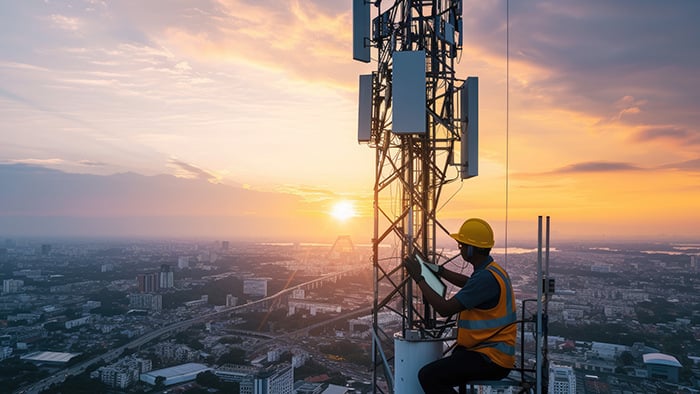What is the metaverse?
The metaverse is a virtual reality of networked 3D worlds where you can socialize, work, shop, and play. Blurring the line between real life and digital life, the metaverse combines virtual, augmented, and physical reality into a graphically rich world that you interact with through an avatar.
It’s still difficult to pin down a metaverse definition, because it’s not an actual technology. The metaverse refers instead to a shift in how we interact with technology. As we continue to explore and develop this new cyber realm, its meaning will inevitably change.
Currently, the metaverse meaning centers on the use of virtual and augmented reality, avatars, and digital ownership, which are already common in the world of gaming. In a way, the metaverse represents a hybrid between the internet and online gaming, where you’re represented by a customizable avatar that interacts with other avatars in an online community.
But although this illustrates the metaverse as it is now, these technologies are not essential to the concept of the metaverse itself. From its current form, the metaverse might expand into an open, interconnected network that could replace the mobile internet as we currently know it.
When will the metaverse be released?
Since the metaverse already exists in the highly immersive world of gaming, there’s technically no metaverse release date. But new developments are already helping to shape and expand the metaverse. Among other things, interactive entertainment, virtual meetings, and educational spaces are all being developed for the metaverse.
But all this innovation makes it difficult to predict where the metaverse is heading. The early internet got started through linked web pages and the long-distance communication between computers. This evolved into the media-rich, dynamic websites, social networks, and apps that have completely altered how we work and live.
Is the metaverse the new internet? Will it use its current building blocks of VR, AI, and digital ownership to fundamentally shift into something else? Major technology companies certainly think so, and they’ve invested billions into exploring and building this new virtual sphere.
Can you use the metaverse now?
You can use the metaverse now, but it’s not currently the revolutionary network it’s expected to become. Currently there are discrete, “mini” metaverses, mostly made up of community-based, online gaming platforms — like Fortnite and Roblox — that use decentralized tech like cryptocurrency and NFTs.
These metaverse platforms may eventually become part of a larger, interconnected metaverse. You can think of these platforms like websites or apps, and the upcoming metaverse as the unified internet that will link them together. Though some metaverse platforms use blockchain technology and NFTs, we’re still far from a unified, decentralized metaverse.
 The metaverse might develop into a network of linked, smaller metaverses.
The metaverse might develop into a network of linked, smaller metaverses.
What’s the origin of the metaverse?
The term metaverse originated in Neal Stephenson’s 1992 sci-fi novel Snow Crash. Stephenson depicted the metaverse as a virtual global market accessed via special goggles or public terminals. Stephenson’s book described the metaverse as a place where you can buy and sell virtual real estate, and he popularized the term avatar to describe virtual bodies in a virtual environment.
What can you do in the metaverse?
Though still in its infancy, the metaverse offers a variety of activities for users. And as the virtual space continues to develop, more activities and other possibilities will follow. Like the development of the internet, the metaverse will build upon the tech available to innovate and grow.
Here’s what you can already do in the metaverse:
-
Customize your avatar: Your avatar represents you in the metaverse. You’re free to alter your body type, hair, gender, accessories — you can even appear as a fictional character.
-
Create VR experiences: Some metaverse platforms, like Horizon Worlds, have pre-built layouts that let you create custom hangout rooms or even layered gaming experiences.
-
Invest in digital real estate: Blocks of land called parcels in metaverse platforms can be purchased with cryptocurrency, and then sold or leased by their owners.
-
Collaborate with co-workers: The metaverse hosts remote working environments with virtual collaboration tools such as virtual meeting rooms, infinite white boards, and VR keyboards.
-
Meet and make friends: Social networking is touted as one of the top metaverse use cases, allowing you to interact with people from all over the world in an immersive VR experience.
-
Shop: In the metaverse, you can browse VR shops and virtually interact with items before you buy.
-
Play VR games: Many of today’s metaverse platforms developed from games, and VR gaming is still one of the main uses of the metaverse. Besides playing for fun, gamers can also participate in “earn-to-play” activities to earn crypto in the metaverse.
-
Invest in NFTs: Non-fungible tokens (NFTs) are digital signatures or tokens that can’t be replicated and authenticate digital assets on the blockchain. NFTs help assets like digital works of art get bought, sold, and traded. NFTs are also available outside the metaverse, though they’re not as immersive.
-
Sell in-game assets: You can participate in the metaverse economy by creating and selling in-game assets such as avatar skins, accessories, and gaming aids in a digital marketplace.
-
Develop and design products in 3D: Designers can use the metaverse’s interactive and realistic 3D spaces to help develop their ideas through product testing and low cost prototype creation.
 The metaverse offers an array of activities to immerse yourself in.
The metaverse offers an array of activities to immerse yourself in.
Examples of the metaverse
The metaverse is presented as something completely new and different, but that’s not entirely true. Iterations of the metaverse are already available. Though they’re not yet the interconnected network the metaverse is predicted to be (the next stage of today’s internet), these metaverse platforms give a hint of what’s to come.
Here are examples of current metaverse platforms:
Second Life
Created in 2003, Second Life is a multimedia platform that allows people to live a second life online through avatars. Though it’s up for debate whether it’s an actual metaverse, it's a good approximation — a large online community interacting in an immersive and experiential environment.
Pokemon Go
Pokemon Go is an interactive videogame using augmented reality (AR) to blur the lines between actual and digital reality. Though Pokemon Go is not strictly a metaverse platform, many predict AR will be an integral part of the experience.
Fortnite
One of the most successful online games ever created, Fortnite uses its platform and community to create a Fortnite metaverse. The platform hosts live music concerts by big name acts like Billie Eilish and Travis Scott. Plus, major brands use Fornight’s “creative mode” to make content and test out possibilities in the metaverse.
Roblox
Roblox is a gaming platform that lets users create their own game worlds that interconnect with other worlds on the platform. This community makes up the Roblox metaverse. Roblox is used by big brands like Vans, Nike, and Gucci to create virtual worlds that allow users to interact with their products.
Horizon
Developed by Meta, Horizon offers a series of interconnected platforms to help users interact with others via avatars. Along with Horizon Worlds (a virtual worlds platform), Meta offers Horizon Venues (an events platform), and Horizon Workrooms (virtual offices). This VR metaverse is accessed through Meta’s own Oculus Quest 2 headset.
Decentraland
The Decentraland metaverse is a 3D virtual-world platform where users can buy and sell NFT real estate with the platform's own crypto coin. Partly an experiment in decentralization and partly a game, Decentraland is a true Web3 platform.
The Sandbox
The Sandbox metaverse is a pioneering decentralized platform, consisting of a community-driven gaming ecosystem where users can create gaming experiences that can be minted as NFTs. These NFTs can be bought and sold on a marketplace featured in the Sandbox metaverse. Sandbox even has its own crypto, SAND, that’s backed on the Ethereum blockchain.
The Nvidia Omniverse
Omniverse is Nvidia's real-time graphic collaboration platform for 3D design professionals. It allows users to create 3D objects and environments that can be transported to different tool sets where other designers can collaborate. As metaverse environments get more sophisticated, tools like the Nvidia Omniverse will be essential for metaverse creation.
Ready Player One
Ready Player One is a novel — not actually a metaverse — that was adapted into a movie. However, it gives great insight on what a near-future with totally immersive VR may look like. And though the sci-fi source material has a dystopian bent on VR worlds, that’s not necessarily our fate with the metaverse.
How to get into the metaverse
Accessing the metaverse varies from platform to platform. You can enter gaming metaverses as a guest user with just a computer or smartphone — though to truly participate, you’ll need a Windows PC and a crypto wallet. Other platforms require augmented reality glasses or a VR headset.
Even if your Windows computer is optimized for gaming, it still may not be enough. A metaverse platform hosting millions of users requires serious processing power, and for some metaverses the average computer is not enough. That’s why companies are trying to develop tech like smart glasses to help users connect to the metaverse more easily.
Platforms like Meta’s Horizon series require a VR headset to journey into the Metaverse. Meta’s Oculus Quest 2 headset contains tracking cameras to render 3D environments, but also a directly integrated graphics card and storage component to handle processing requirements.
Looking to boost your computer’s processing power? Learn how to safely overclock your CPU and overclock your GPU and get instant results.
How to access the metaverse with a VR headset
A VR headset, like the Oculus Quest 2, is the most immersive way to experience the metaverse. Equipped with a headset, you just need to download the app for a compatible platform.
Here’s how to access the metaverse with the Oculus Quest 2 headset:
-
Power up and put on your Oculus Quest 2 headset.
-
Select the App Drawer from the Universal Menu (use any controller). Your list of installed apps will appear.
-
Select your app.
-
Load the game/app.
Now you have access to a whole new VR world.
How to join the metaverse without a VR headset.
You don’t always need a VR headset to access the metaverse. Several metaverse platforms are browser-based and do not require special hardware. Some, like Decentraland and Roblox, simply require a computer or a smartphone.
Here’s how to access some metaverses without a VR headset:
Decentraland
Decentraland is one of the most popular 3D virtual world platforms within the metaverse. Here’s how to access it:
-
Go to the Decentraland website and click Start Exploring in the top-right corner.

-
You have two options: Play as a guest or Play using your wallet.

-
If you play as a guest, the game will now load. If you play using your wallet you’ll be prompted to connect your crypto wallet before the game loads.

Guests in Decentraland are limited to exploring the land and customizing their avatar. If you play using your wallet, you can actively participate in playing, buying land, and creating assets.
Sandbox
Sandbox is another popular platform where users can create gaming experience NFTs to buy and sell. While you don’t need a headset, it’s recommended that you have the MetaMask crypto wallet.
Here’s how to access the Sandbox metaverse:
-
Go to the Sandbox website and click the Sign In button in the top-right corner.
-
When prompted, connect your crypto wallet (MetaMask is recommended).
-
Enter your username, email ID, and password.
-
Click Create on the box on the left.
-
Download and install the GameMaker on your PC.
-
Open the app and sign in.
Now you can play and create custom Metaverse game experiences, which you can mint into NFTs — just be sure to monitor screen time for kids and yourself, as these experiences can be highlighly immersive (and addictive).
What is Facebook’s metaverse?
Facebook now goes by the name of Meta — a clear indication of how much the company has staked its future on the Metaverse. Their Horizon series of metaverse platforms, much like Facebook, is focused on user interactions, and it offers virtual spaces for events, hangouts, and collaboration.
However, this is only the early stages of Meta’s foray into the metaverse. The company has already invested billions into developing metaverse technologies, and it’s clear that CEO Mark Zuckerberg is a true-believer in the metaverse and its potential to fundamentally alter the way we work, play, shop, and live online.
What are the risks of the metaverse?
As with other online platforms, cyberbullying, social engineering, and identity theft are all common risks associated with the metaverse. And by further blurring the distinction between virtual worlds and reality, the metaverse is likely to heighten the harmful impact of malign online activity.
Metaverse risks also pose a number of new challenges — in particular, metaverse crypto usage. Many platforms require users to own a crypto wallet, which not only holds digital assets but can also be tied to your online persona. Maintaining digital literacy and understanding the rules of netiquette can help keep you safe while acclimating to the metaverse. As always, use two-factor authentication to protect your accounts from hackers.
Protect your online privacy and security with Avast
Both in and out of the metaverse, strong cybersecurity tools are essential. As technology becomes increasingly integrated, hackers will find new ways to attack. Avast One provides ironclad cybersecurity and an assortment of powerful privacy tools to keep you safe online.
On top of an award-winning antivirus, Avast One features a built-in VPN, data-breach monitoring, and even device optimization tools to ensure comprehensive device security and performance. Protect all your devices right now with Avast One.



 The metaverse might develop into a network of linked, smaller metaverses.
The metaverse might develop into a network of linked, smaller metaverses. The metaverse offers an array of activities to immerse yourself in.
The metaverse offers an array of activities to immerse yourself in.













